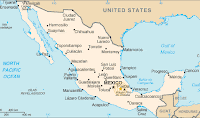Legends creating a fantastic city!
As I mentioned before, Puebla is surrounded by Legends that are about its foundation up to nowadays. These Legends colored Puebla's History...
"La China Poblana"
During colonial times in Mexico, the viceroy of New Spain, Marques de Galvez, made to be brought from Philippines a young slave to his personal service. The name of this girl was Mirra, she was a daughter of a Mughal King, who had to leave his town and seek refuge, but soon after Mirra was kidnapped in India by Portuguese pirates and slave traders, and carried her to Cochin, a city located at the south of this country . In this place she could escape from their captors and took refuge in a Jesuit mission, where she was host and named Catarina de San Juan. Unfortunately for Mirra, some years later, the pirates found her and abducted her again, bringing with them to Manila, where she was sold to the merchant who took her to the New Spain. However, on landing in the port of Acapulco, this merchant found a highest bidder, who offered him ten times the price offered by the Viceroy. Others use to say that he completed a previous order. It was the poblano Miguel Sosa, who took her to Puebla for his service.
The marriage of Miguel Sosa had no children and adopted Catarina as his daughter, but she did not lose her status as slave. By then, people used to call the female servitude "chinas" so that's how people started to use to call her. However, she learned to speak the Spanish language, she learned to cook, but never learned to read or write. Dressed in the style she used in his homeland, it was the origin of the legend, the dress of "The China Poblana".
On January 5th, 1688, she died at the age of 82 years. Many people attended his wake. She was buried in the sacristy of the Compañia de Jesus, where his remains are still preserved.
"The legend of Popocatepetl and Iztaccihuatl"
It remains to the Aztec's Era, during the war between the Aztecs and the Tlaxcala. It is a colonial legend, nor the city of Puebla, has actually happened in the well before the arrival of Spanish conquerors, but has been told for generations in the entire region of Mexico, Puebla and Tlaxcala.
It turns out that the daughter of tlaxcalan Chief, named Iztaccíhuatl, was in love with one of the young warriors of his father. So great was her love, and with the obligation to go to war, the young man asked for the hand of the princess before leaving, so that in the event of return victorious, would immediately marry her. The chief agreed and gave the hand of his daughter when she returned to Popocatepetl, which was the name of this brave young man, and held the wedding.
Thus, Popocatepetl went to war with men and arms to fight for the freedom of his people against the Aztecs. It turns out that after a certain time, another man, who was in love with the princess Iztaccihuatl, and returned to the village before the war ended, he falsely informed the chief that Popocatepetl had died in battle. The princess heard this conversation, until a short time, died of sadness that he could not overcome.
After the war, as promised, Popocatépetl returned victorious only to learn of the recent death of his beloved. They had no sense of the chief pledges, because the main reason for their fight was gone.
 He decided to honor their loved making a very particular tomb: twenty thousand men built a large hill facing the sun, to remain in the memory of subsequent generations, where he carried the lifeless body to place it on top. He kissed her with a torch in his hand, knelt beside her, watching her eternal sleep. Snow blanketed their bodies and thus, over time, became the volcanoes that we can now appreciate from the city of Puebla.
He decided to honor their loved making a very particular tomb: twenty thousand men built a large hill facing the sun, to remain in the memory of subsequent generations, where he carried the lifeless body to place it on top. He kissed her with a torch in his hand, knelt beside her, watching her eternal sleep. Snow blanketed their bodies and thus, over time, became the volcanoes that we can now appreciate from the city of Puebla.
So stay forever in love, and occasionally, Popocatepetl, remembering the love of Iztaccihuatl, shakes the earth and torch revives the fire in his heart, which springs from sorrow and smoke visible from far away.
From then until shortly before the Spanish arrived, the hapless maidens love dead were buried in the Iztaccihuatl volcano.
 Incidentally, this man who decided to report that Popocatepetl was fallen in battle, could not bear the guilty conscience for having unleashed such a terrible tragedy, and made his way out of town to die alone and disoriented. His body was also covered by snow, making the time to remain ever watchful volcano who wished to separate, becoming the volcano Pico de Orizaba, which means "Star Mountain" and is now known as the Pico de Orizaba.
Incidentally, this man who decided to report that Popocatepetl was fallen in battle, could not bear the guilty conscience for having unleashed such a terrible tragedy, and made his way out of town to die alone and disoriented. His body was also covered by snow, making the time to remain ever watchful volcano who wished to separate, becoming the volcano Pico de Orizaba, which means "Star Mountain" and is now known as the Pico de Orizaba.
The valley of Puebla is located precisely between these three volcanoes. ᵜᵅᵖᵜ



















